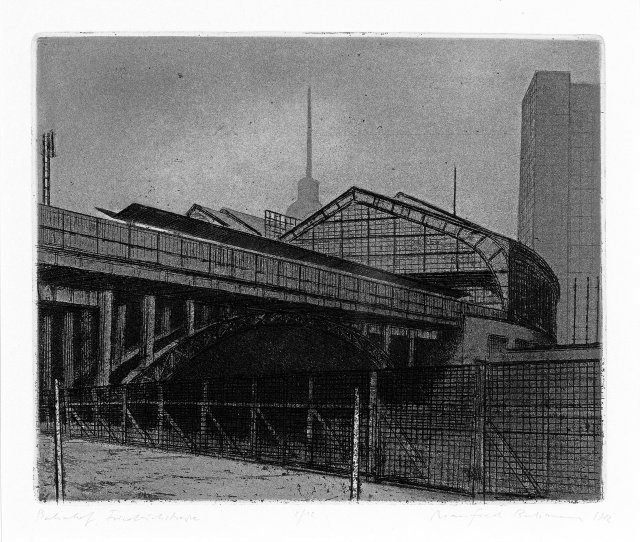Kunstforum Berliner Volksbank | Expulsion from Paradise
The vast majority of people today live in urban areas, metropolitan areas, or small towns. The city, as a field of tension, is therefore one of the most common subjects in the visual arts, where society is negotiated and questions about the future are raised.
This can currently be beautifully seen in the exhibition "Residential Complex: Art and Life in Prefabricated Housing" at the Potsdam art gallery "Das Minsk." The serial, typologized housing typical of the GDR, as an iconic symbol of a socialist lifestyle, receives a belated appreciation in this exhibition. Approximately 50 works are on display that explore the phenomenon of prefabricated housing from various perspectives. It is astonishing that a large portion, if not the majority, of the assembled works date from the period after 1990 to the present day. The typologization of housing has apparently not lost its dubious fascination to this day, as it represents a social vision and its failure.

One of the artists represented is the East Berlin painter Christian Thoelke. Born in 1973, he is a prototype of a generation that still suffers from an at times inexplicable phantom pain and is no longer afraid to describe the fall of the GDR and its consequences as an experience of loss. Thoelke made a name for himself with large-format paintings that depict the decline in significance of prefabricated housing after reunification and use them as a starting point for elegiac motifs of loss and demolition. His picture of the graffiti-covered ruins of a "Kaufhalle" (department store), hanging in Potsdam, speaks of a mental homelessness that cannot be compensated for by the exuberant range of goods offered by consumer society.
Thoelke's paintings are part of the ongoing search for a new and different narrative, with which East Germans are gradually (re)claiming their history and its interpretation. Concurrent with the exhibition in Potsdam, his paintings are currently on display at the Kunstforum Berliner Volksbank, deep in West Berlin's Charlottenburg district, until December. The exhibition "Paradise" brings together Thoelke's paintings from recent years, all of which revolve around the theme of identity solidified into concrete. Once an expression of a social utopia, he gazes from the present upon its remnants and finds: no more vision, nowhere. The views of abandoned prefabricated buildings, disused playgrounds, or empty convenience stores radiate the melancholy of decay without offering any escape.
The exhibition, however, goes far beyond this; Thoelke was permitted to select works from the Berliner Volksbank art collection and allow them to enter into a dialogue with his own paintings. With few exceptions, he opted for a retrospective look at the art of the late GDR, which significantly broadens his own perspective and makes the early influences and influences more comprehensible. One must truly thank Thoelke for allowing us a re-encounter with names rarely seen today, but once so well-known, such as Arno Mohr, Ursula Strozynski, Manfred Butzmann, Trak Wendisch, Konrad Knebel, and many other East German artists.
For full-blown melancholics, East Berlin in the 1980s must have been a stone expression of their attitude to life.
What's particularly astonishing about this compilation is that an institution like the Stiftung Kunstforum Berliner Volksbank (West) apparently began collecting art from the GDR at a time when it was not highly valued in the West German discourse. This is now paying off, as this art has since undergone a significant reappraisal.
The selected works are far from ideologically overburdened "state art" anyway. They limit themselves to depicting the city, although these urban landscapes should certainly be seen as a reflection of their time. Westerners who visited East Berlin before 1989 often report that it seems to them as if the post-war era has been preserved here.
Indeed, for full-blown melancholics, East Berlin in the 1980s, especially the old buildings in Prenzlauer Berg or Mitte, must have been a stone expression of their attitude to life. All those images of weathered firewalls, backyards, and tenement blocks, for which Konrad Knebel stands above all else. Even if his naturalistic oil paintings from Prenzlauer Berg show only a glimpse of the city's overall picture, they are nevertheless historical documents that reflect the internal and external stagnation of a declining state. Today, they are a distant memory of how deeply the decaying buildings and stagnation shaped the city and its attitude to life.
Naturally, artists like Knebel, but also Butzmann, Strozynski, and others, were accused by officials of merely depicting the dark corners of the capital, but not the representative sites of socialist urban development. At least for the graphic artist Manfred Butzmann, this accusation cannot be sustained; in his portfolio of prints, "Stone Berlin," which the exhibition comprehensively presents, Butzmann certainly incorporated many motifs of the new Berlin. But, alas, those responsible for art can hardly have been pleased with that either, since Butzmann's etchings point out many inconsistencies: buildings that stand at odds with one another, whose proportions do not relate to one another, on the contrary, destroy them.
These prints are complemented by Ursula Strozynski's etchings of Berlin locations and Trak Wendisch's series "Berlin Bridges." Both understand architecture as a built system of values, and it's no coincidence that both images exude a certain melancholy that was probably quite close to the spirit of the time. Many of the works in the exhibition relate to each other in this way, forming a multi-voiced chorus.
"Paradise. Urban Landscape as a Mirror of Time" runs until December 7th at the Kunstforum Foundation of the Berliner Volksbank, Kaiserdamm 105 in Berlin-Charlottenburg. "Residential Complex. Art and Life in a Prefabricated Building" runs until February 8th, 2026, at the Kunsthaus "Das Minsk" in Potsdam.
nd-aktuell


